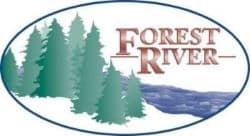This is a brief introduction to the Park Model type of RV, intended to provide essential information for choosing the best RV type. (Looking for Park Model Manufacturers?)
Not sure if this is the right RV type for you? Please take a look at our RV Types Pros & Cons Checklist.
What Is a Park Model RV?

Definition of a Park Model RV
A park model RV (PMRV) is a recreational vehicle designed to be parked permanently on a developed campsite with full hookups (FHUs).
Park Model RVs look like Tiny Houses or mobile homes; they aren’t either. By legal classification, park models are RVs built under the ANSI A119.5 Park Model Recreational Vehicle Standard. However, PMRVs were arguably birthed from the Tiny-Home-on-Wheels movement, so they share many similarities.
PMRVs are commonly confused with destination trailers, which are technically a type of travel trailer (although some PMRVs are marketed as “destination trailers”!). You can read more about destination trailers here.
Unlike motorhomes, you tow (you don’t drive) a Park Model RV.
Unlike most other RVs, you may need a special license to tow one! PMRVs commonly weigh in excess of 10,000 lbs and are often wider than 102″, the maximum legal width on most roads to be towed without a wide load permit.
Park Model RV Specifications
Dimensions
- Lengths range from 24 to 44 feet, with 28 to 40 feet being the most common.
- Width ranges from 8 ft to 15 feet, with 10-14 feet being the most common.
- Height varies from 11 to 16 feet, with most ranging between 12.5 and 14 feet (A/C included).
PMRVs are limited to 400 square feet or less in setup mode. For more information, see the RVIA PMRV Advocacy Policy.
In most places, any vehicle over 8.5 feet wide and/or 13.5 feet tall requires a transportation permit. In some locations or states, the limits may be even less!
It is usually much easier and simpler (and less expensive) to obtain a permit
In genera, obtaining a permit for transporting a wide load up to 12 feet wide is far easier than 14 feet, which in turn is far easier than 16 feet. Vehicles 14 feet and wider are restricted from many public roads, requiring large detours – or access to a certain location may be impossible!
Driving an RV for the first time? Check out our guide to what you need to know about length, width, height, and weight!
Sleeping Capacity
Most Park Model RVs can fit 6-12 sleepers (8-10 standard). That doesn’t mean there’s room for everyone to sit down at dinner at the same time, though!
Park Model Categories
PMRVs are commonly confused with destination trailers, which are technically a type of travel trailer (although some PMRVs are marketed as “destination trailers”!). You can read more about destination trailers here.
Generally, PMRVs can be divided into two categories:
- Those constructed like conventional trailers
- Those constructed like a tiny-house-on-wheels
See the section on sub-types for more information on park model RV categories.

Park Model RV Description
The park model is a travel trailer that requires park facilities to function. It lacks dual-voltage appliances, requiring to be plugged into water, sewage, and electrical facilities.
Because of these limitations, park models are ideal for long-term or permanent placement as a vacation home. Often these trailers are placed in a park, skirting is added, a deck is built by the entrance, and occasionally additional rooms are added.
PMRVs are a relatively new type of RV, inspired by the advent of Tiny Homes. While they may look like tiny homes or mobile homes, Park Models are built to a different code and are not intended for full-time residential living.
Park Model RV Chassis & Fuel Economy
Virtually all park model RVs are built on a flat-tow (travel trailer) chassis. This allows the RV to have the traditional boxy, rectangular structure of a cottage or cabin.
PMRVs chassis are available in two basic types:
- Deck-between, where the body sits in between the wheels and fenders. This increases height but reduces maximum body width to 11′ 8″ or less, usually.
- Deck-over, where the body sits above the wheels. This restricts available height but maximizes body width.
There is usually about a 1-ft difference in ground clearance to the camper body (24″ an 36″, respectively) between a deck-between and deck-over PMRV.
As of now, there are not many PMRV chassis sourced from major manufacturers. This is because many PMRV manufacturers are custom builders who design and even fabricate their own chassis.
Most PMRV frames are similar: A ladder-type A-frame design with robust I-beam main beam construction and C-channel cross members. Some designs use tube steel instead of I-beam or C-channel. Weight is not much of a concern, so fabricators normally stick with stock structural steel extrusions.
Leaf-spring suspensions are par for the course. Triple axles are common, although tandem axles may be used on smaller RVs. Again, since the RV is not intended to be towed except once or twice a year, at most, designers stick with tried n’ true steel rims rather than lightweight aluminum.
Many park models are built with removable axles and hitches so the unit can be mounted on a semi-permanent raised foundation at a campground. Then skirting is added to enclose the underbelly, and the PMRV looks just like a cottage house!
Who Might Want a Park Model RV?
There are three potential customers for a PMRV:
- Snowbird
- Weekend Vacationer
- Campsite Owner
Snowbird RVers, those who seasonally relocate to follow the good weather, may enjoy the home-like spaciousness of a PMRV. You can purchase one of these units and park it at your favorite Florida campground. If you plan to move the RV more than once every few years, though, you’d be better off with a destination trailer or full-timer luxury 5th wheel.
Vacationers who frequent the same favorite locales – say, a favorite ski, beach or mountain resort – may choose to purchase a PMRV and sign a long-time rental contract with a campground. Whenever the family chooses to ski or swim, the RV is already parked, ready and waiting. Consider it your permanent getaway dream house.
Campground owners may choose to purchase a PMRV and rent the unit as a cottage to their guests. This is a flexible alternative to building traditional camping cabins, which are permanent structures and may be subject to local building codes.
Park models are NOT a good choice for a mobile RV! Here are some reasons why.
- Not only are they heavy and oversized …
- But the design itself is not well-suited to constant travel. The vapor barrier inside double-pane windows, for instance, may break during travel, allowing the glass panes to fog up inside.
- Storage cubbies are not designed to hold gear while in transit. You may need to partially empty your unit before transportation. And transportation companies may even insist the unit be empty to avoid liability.
- Setting up and breaking down a PMRV can take days, not hours. Some require additional protection for the doors, windows and other features. Some have removable wheels and axles which must be added by a professional mover.
- And the RV cannot be used unless it is placed in a site with full hookups.
Park Model RV Pros and Cons
PROS
- Looks and feels just like a house!
- May include a built-in front porch.
- Not limited to the narrow 96-102″ waist of a traditional RV; more floorplan flexibility
- Accessible second-story loft, possibly with staircase
- Residential-style furnishings and accouterments
- Designed for 24/7 exterior exposure
- Maintenance similar to a traditional home
- Not paying for the unused features of a luxury 5th wheel or destination trailer
- Better insulation and 4-season capability
- Easier to customize the construction.
CONS
- Extremely heavy and bulky!
- Not self-contained; can only be used in a campsite with full hook ups.
- No 12V appliances; 120V AC service only.
- Cannot be towed by most private individuals; needs a professional moving service and permits.
- Setting up and breaking down can require days of prep work.
- Many RV campgrounds do not accept PMRVs under any circumstances.
- Somewhat new RV category; not well-supported nationwide.
- One of the most expensive types of RVs due to custom craftsmanship and low-volume production.

Key Features in a Park Model RV
Residential Construction
Park Model RVs are usually constructed with traditional framing practices and techniques, such as stick-framed walls (2×4 studs 16OC0, cathedral peaked roofs, fiberglass wall insulation, etc.
You may see overhanging eaves, soffits, peaked roofs, transom windows, staircases, skylights, and other architectural features rarely seen in other RVs.
This type of construction is better suited to 24/7 outdoor exposure and full-time living.
Unlike conventional RVs, park models rarely have built-in waste tanks, house batteries or water pumps. The units are designed to be connected to city utilities, such as 60 Hz, 120V AC electricity, city water supply, and a dedicated dump station.
Park model RVs also commonly have mini-split air conditioners rather than rooftop A/Cs. Mini splits are quieter, more efficient, and can act as a heat pump as well.
Here is a park model RV layout, the 2022 Forest River Premium Cabin APC-PC-33FP (available only to campground owners). As you can see, the floorplan has a more typical residential layout, such as a front porch, 5×8 bathroom, 4-person breakfast table nook, ceiling fans, etc.

Width Restrictions
The width of your park model RV has an enormous impact on how easily it can be relocated.
- At 8′ 6″ and below, the RV can usually be transported without a permit. On local roads, 8′ wide may be the maximum with a permit. Any width greater than 8′ 6″ requires a wide-load/oversize permit.
- Obtaining a permit to transport loads between 8′ 6″ and 12″ is generally fairly simple. An approved route is required.
- Depending on state law, once a load exceeds 12′ to 14′ in width, extra restrictions kick in, such as pilot vehicle escorts and limited permitted travel times.
- Anything wider than 16′ is a super-load. Temporary road closures may be necessary to move the unit. Fees are extremely expensive.
Remember that oversize permits are issued by State Departments of Transportation! So any trip across state lines requires an additional permit from that state – and rules may vary between states.
Park Model RV Sub-Types
Unlike other types of RVs, park models don’t lend themselves well to subcategories, because every company does it differently!
- Lancaster Log Cabins, for instance, builds actual log cabins complete with beautiful interior hardwood craftsmanship.
- Forest River builds vinyl-sided cottages targeted to campground owners looking for rental units.
- B&B tiny houses build rustic/modern tiny houses for business offices, part-time residences, disaster relief and more!
Unlike mainstream RV manufacturers who are known for churning out thousands of doppelganger RVs, PMRV builders are known for high-end customization and craftsmanship. Speak with your builder about what you have in mind.
PMRVs are commonly confused with destination trailers, which are technically a type of travel trailer (although some PMRVs are mistakenly marketed as “destination trailers”!). You can read more about destination trailers here.
Park Model Major Manufacturers
There are about 7 major park model RV manufacturers in North America.
Some of the biggest names include:
- Athens Park
- Forest River
- Crossroads RV
- Woodland Park
- Cavco
For a full list of manufacturers, check out our comprehensive RV manufacturer’s list!
There are also many smaller custom coachbuilders who will design you a PMRV or tiny house designed to your specifications. Be aware that many smaller builders are not RVIA-certified, however, which means they do not necessarily comply with any construction codes and their units may not be accepted at any campground. Double-check that you will be provided a proper Manufacturer’s Certificate of Origin and will have no trouble obtaining a title from your local DMV.
We’ve spotlighted a few brands below. These brands are either known for their popularity, quality, or innovation.
Athens Park Homes

Athens Park model homes, based in Athens, Texas, builds cottage- and cabin-style park model RVs. The company employs an assembly-line production process and has eight servicing facilities across the United States. The
Tumbleweed Tiny House Company

Technically, Tumbleweed does not belong on its list. Most of its units are 8′ 6″ wide and are considered regular RVs, not PMRVs.
However, Tumbleweed is one of the iconic faces of the Tiny House on Wheels movement, so it’s a close competitor to the other companies. The company builds four series of tiny house RVs, from the cedar plank Elm cottage to the ultra-modern, spacious Farallon. Their little Cypress is the best-selling THOW of all time, starting at $84,000 for their 2022 lineup.
Forest River

The Park Model division of Forest River builds plank-sided PMRV cottages. They offer seven model series, two of which are exclusive to Canada, and two of which are exclusive to campground owners (and one of those is exclusive only to KOA).
Lancaster Log Cabins

Based in Lancaster Pennsylvania, the heart of Amish/Pennsylvania Dutch country, Lancaster Log Homes is one of the only companies in the world that makes a real log park model cabin. Their 12′ wide Sierra log cabins are a cult-favorite. If you love the look of knotty pine or red cedar, you’ll love their PMRVs! Prices start at $58,900 and up for their 2022 model lineup.
Park Model RV FAQs
Park Model RVs look like Tiny Houses or mobile homes; they aren’t either. By legal classification, park models are RVs built under the ANSI A119.5 Park Model Recreational Vehicle Standard.
Meanwhile, mobile homes are built to the Manufactured Home Construction and Safety Standards (HUD Code). And there is no formal designation or support for a Tiny Home, although private independent groups, like NOAH, have formed to fill the gap.
Related RV Checklists
The following RV checklists on our web site are applicable to park model RVs:







